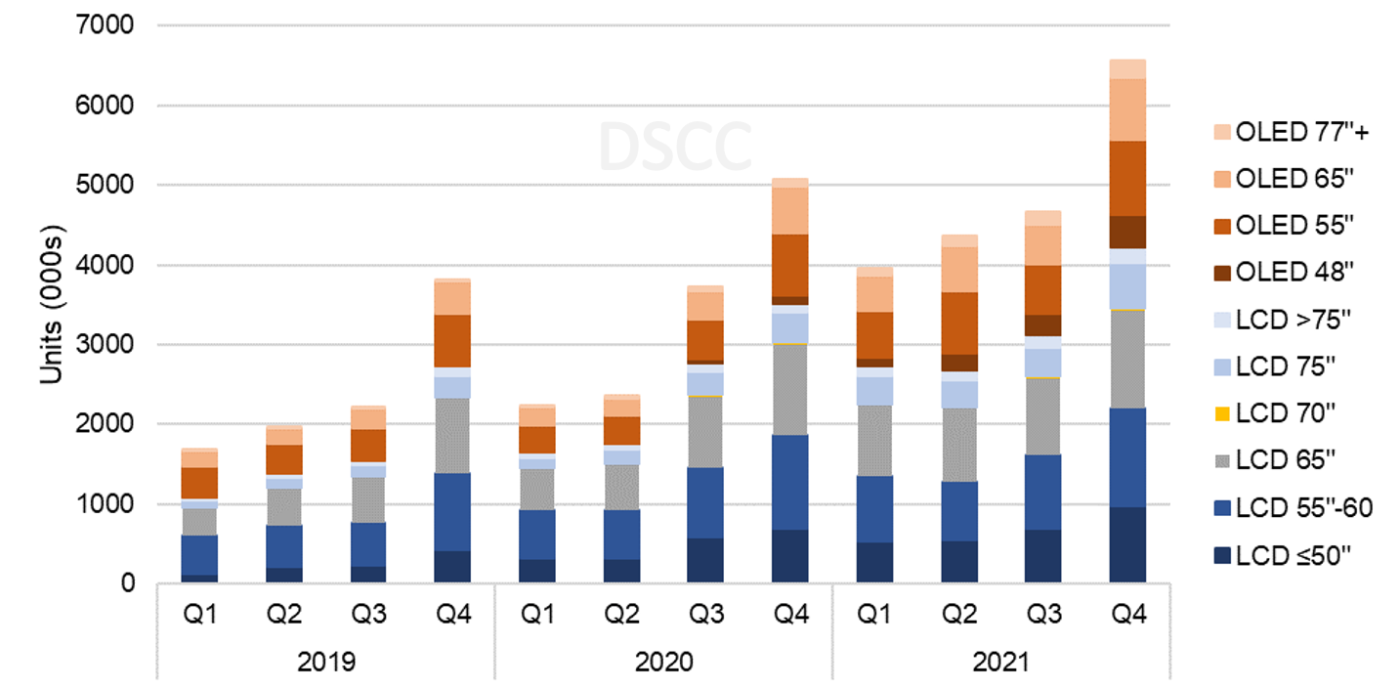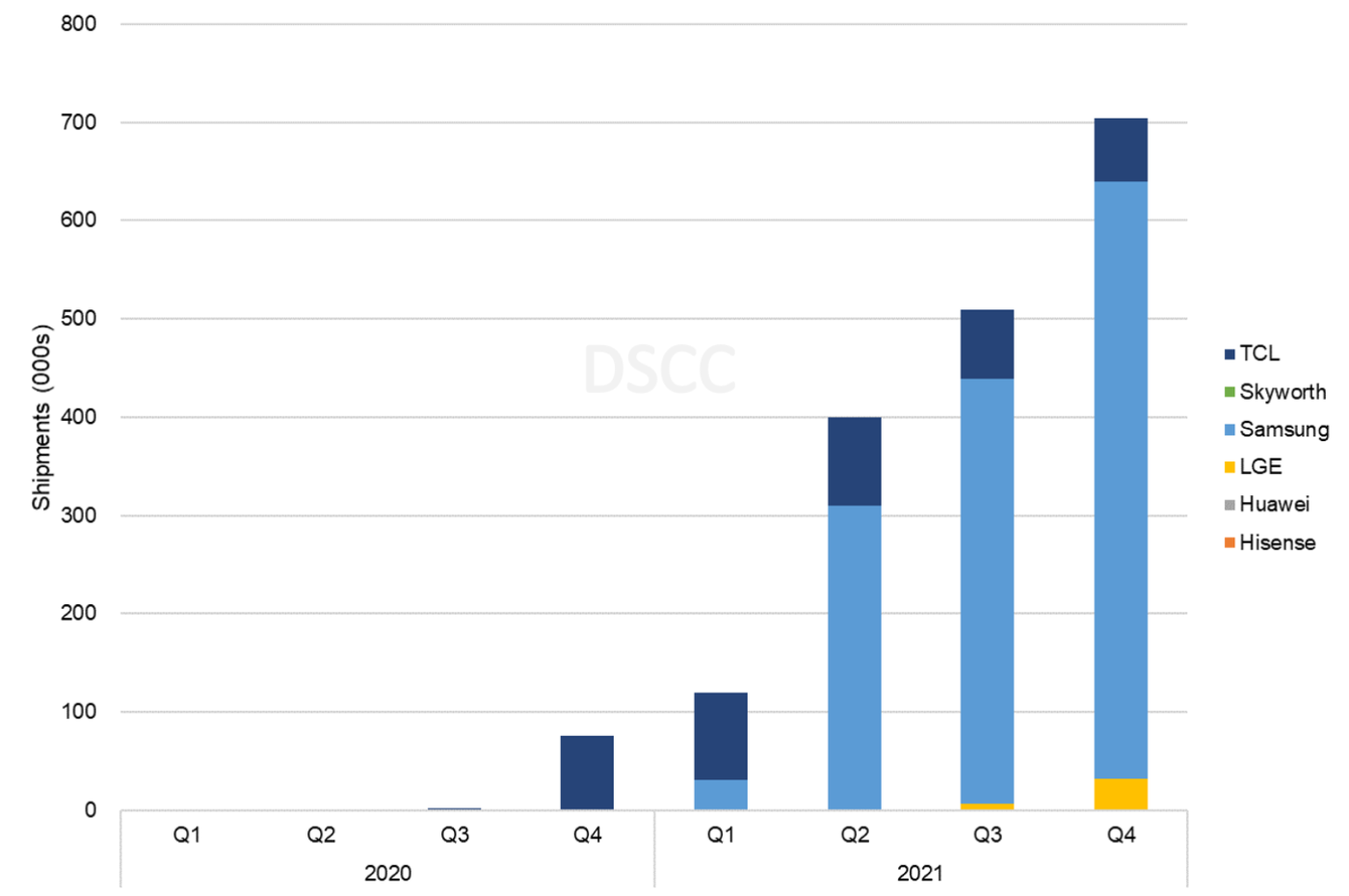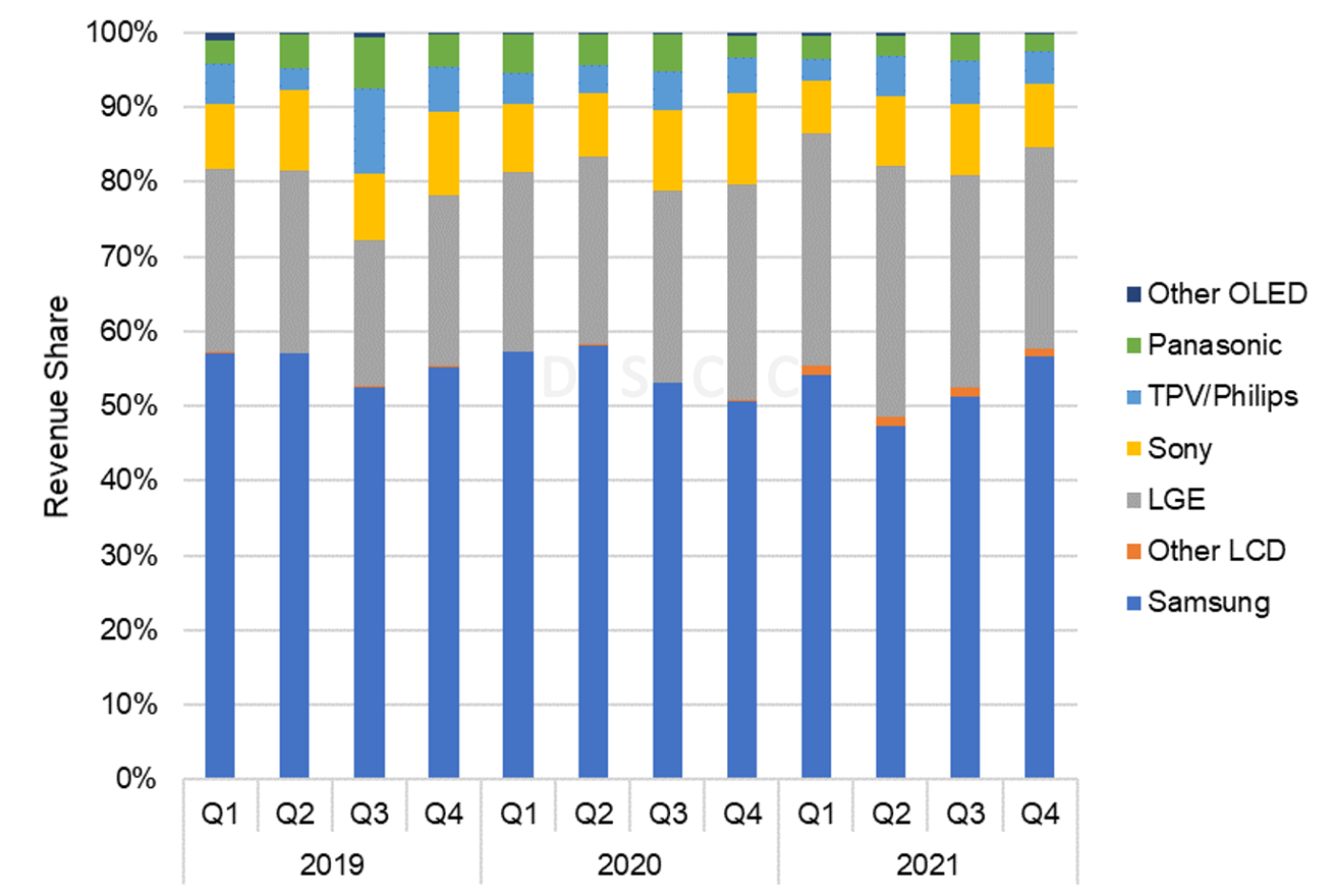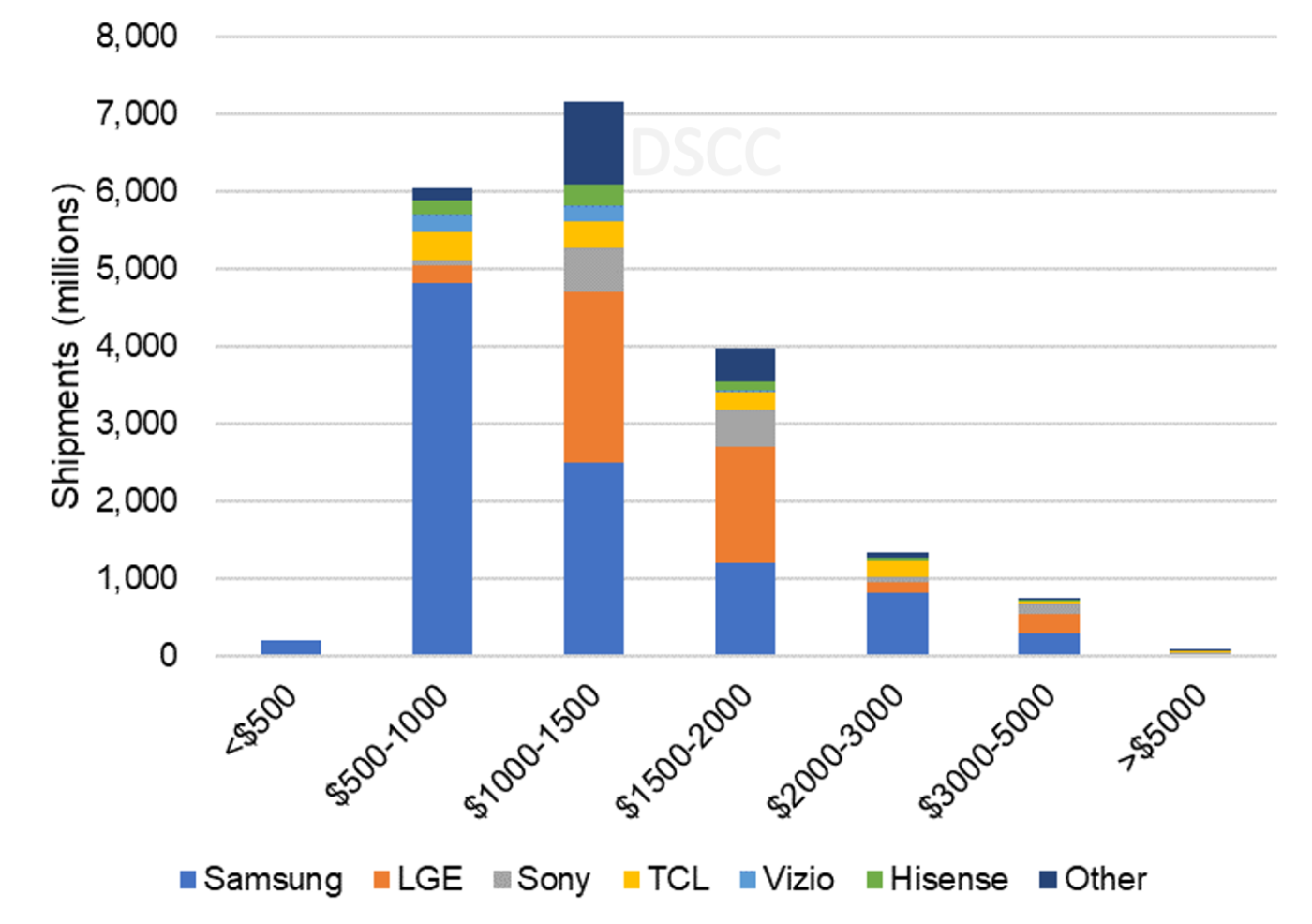Q4'21のAdvanced (先端技術FPD搭載) TV市場、LCDとOLEDの争いが白熱
冒頭部和訳
LCDテクノロジーとOLEDテクノロジーの戦いはQ4’21になって新たな段階に突入、各陣営はそれぞれの強みを発揮して躍進した。OLEDが積極的な価格設定で出荷台数シェアを伸ばした一方で、LCD TVの価格上昇、大型画面の比率上昇、MiniLED TVセットの増加によって、LCD TVが出荷金額シェアを伸ばしている。
DSCCが Quarterly Advanced TV Shipment and Forecast Report (一部実データ付きサンプルをお送りします) 最新号をリリースした。ブランドレベルでは、SamsungがAdvanced (先端技術) TV市場でシェアを下げたが、製品構成が豊富なことから、同社の出荷金額シェアは世界規模で安定している模様だ。
本レポートは、最先端TVテクノロジー (WOLED、QDディスプレイ、QDEF、4Kおよび8K解像度のMiniLED) を含む、世界のプレミアムTV市場を対象としている。テクノロジー/地域/ブランド/解像度/サイズの各項目別に現在と将来のTV出荷台数と出荷金額を調査、これらすべてのテクノロジーの成長について予測している。今回リリースの最新号にはQ4'21の出荷実績を収録している。 2026年までの予測の最新版は今後数週間以内に公開予定である。
当社では「Advanced TV」を、すべてのOLED TV、8K LCD TV、および量子ドット技術搭載のすべてのLCD TVを含む、先端ディスプレイ技術機能を備えたTVと定義している。本レポートの実績データによって、以下のような先端技術LCD TVの機能別分析が可能である。
- QDEF TV:量子ドットエンハンスメントフィルムを使用したTV。Samsung、TCL、その他のメーカーから「QLED」として販売されている。
- MiniLED:MiniLEDバックライト搭載のLCD TV。2019年にTCLが発売、2021年にSamsung、LG、Hisenseなどが導入している。
- デュアルセル:デュアルセルテクノロジーを採用したLCD TV 。2019年にHisenseが導入したが、このテクノロジーはTV分野では行き詰まっている模様で、過去数四半期にわたり出荷が確認されていない。
- LCDその他:他のカテゴリーに分類されない8K解像度のLCD TVを含むカテゴリー
Pitched Battle Between LCD and OLED in Advanced TV Market in Q4 2021
The battle between LCD and OLED technologies reached a new stage in Q4’21 with each camp making gains by playing to their strengths. Aggressive OLED pricing allowed the emerging technology to gain unit share, but a combination of higher LCD TV prices, a bigger screen size mix and the growth of MiniLED TV sets allowed LCD TV to gain revenue share.
The latest update of the DSCC Quarterly Advanced TV Shipment and Forecast Report (一部実データ付きサンプルをお送りします) is now available to subscribers. On a brand level, Samsung has lost share in the Advanced TV market, but with a richer product mix, Samsung has appeared to stabilize its revenue share on a worldwide basis.
This report covers the worldwide premium TV market, including the most advanced TV technologies: WOLED, QD Display, QDEF and MiniLED with 4K and 8K resolution. The report looks at current and future TV shipments and revenues by technology, region, brand, resolution and size, and forecasts the growth of all these technologies. This update includes the shipment results for Q4’21; an updated forecast out to 2026 will be published in the next few weeks.
We define an “Advanced TV” (capitalized) as any TV with an advanced display technology feature, including all OLED TVs, 8K LCD TVs and all LCD TVs with quantum dot technology. The historical data in the report allows an analysis by feature for Advanced LCD TVs, including:
- QDEF TV: TV using a Quantum Dot Enhancement Film; these TVs are sold as “QLED” by Samsung, TCL and others;
- MiniLED: LCD TVs with a MiniLED backlight, as sold by TCL starting in 2019 and introduced by Samsung, LG, Hisense and others in 2021;
- Dual Cell: LCD TVs employing dual-cell technology, as introduced by Hisense in 2019, but this technology appears to be a dead end in TV; there have been no shipments for the last several quarters;
- LCD Others: this category includes LCD TVs with 8K resolution, that do not fall in any other category.
The historical data for OLED TV includes only one product configuration, LGD’s White-OLED (WOLED) technology, but the forecast in the report includes QD Display, which designates QD OLED and successor technologies such as QNED and EL-QLED, as well as Rollable OLED and MicroLED. Our forecast for MicroLED TV is based on product sizes up to 110”, as products in larger sizes such as Samsung’s 146” The Wall, belong in a different category than “TV”.
Advanced TV shipments in Q4’21 increased by 29% Y/Y to 6.6M units, as shown in the first chart here. In volume terms, OLED TVs had the biggest gains as Advanced LCD TVs have lost share because of high panel prices. All screen size groups for OLED TVs increased Y/Y, with the biggest gains in 48”, up 276% Y/Y and 77” and larger, up by 116%. The 48” OLED TV models were introduced only in Q2’20 but already represented 18% of OLED TV volume in Q4. Similarly, 83” OLED TV sets were introduced in Q2’21 helping to drive growth in 77”+. Within the LCD category, shipments for the high-volume 55” and 65” sizes recorded only single digit % gains, but 75” increased by 57% Y/Y and Advanced LCD TVs larger than 75” increased 67%.
While OLED TV share of all Advanced TV had declined during 2018-2020, the additional capacity from LG Display’s Guangzhou fab combined with the steep increases in LCD TV panel prices up through Q2’21 has helped OLED TV regain share in the premium category. OLED TV shipments increased by 50% Y/Y in Q4’21, and OLED TV unit share increased from 31% in Q4’20 to 36% in Q4’21.
Advanced TV Shipments by Size and Display Technology, 2018 to 2021
Advanced TV revenue growth in Q4 was substantially higher than unit growth at 50% Y/Y, but while unit growth was driven by OLED, revenue growth was driven by LCD. Revenues for Advanced LCD TVs grew 55% Y/Y despite lower growth in unit shipments as a function of three factors, general price increases, a bigger screen size mix and the introduction and growth of MiniLED TVs at higher prices. Revenues for Advanced LCD TVs larger than 75” grew 123% Y/Y. OLED TV revenues increased 43% Y/Y and OLED revenue share decreased from 44% in Q4 2020 to 42% in Q4’21.
The report’s pivot tables allow an analysis of brand share by screen size, region, technology, resolution and other variables. In Q4’21, among all Advanced TV products, Samsung maintained its leading position but lost some share with unit shipments up 17% Y/Y, less than the market growth. LG Electronics increased shipments by 67% with big increases in OLED and some sales of Advanced LCD TVs and LG’s share increased from 18% in Q4 2020 to 23% in Q4’21. Sony Advanced TV shipments increased by 36% Y/Y and TCL shipments increased 30% Y/Y and both companies held share Y/Y at 7% and 5%, respectively.
The report divides worldwide shipments into eight geographic regions. Western Europe and North America have continued to be the largest regions for Advanced TV. These two regions represented a combined 64% of Advanced TV units and 69% of revenue in Q4’21. Shipments to Western Europe increased 15% Y/Y in Q4’21 and revenues increased by 25% Y/Y. Shipments to North America increased 25% Y/Y and revenues increased 46% Y/Y as sales of big TVs surged. China, where shipments were flat Y/Y in Q3, resumed growth with a 29% Y/Y increase in Q4 as declining LCD TV panel prices started to kick in and as OLED gained some share with increasing sales of OLED TVs made with panels produced locally in LGD’s fab in Guangzhou.
The report tracks the emergence of MiniLED as a competitor to OLED TV in the premium space. The next chart here shows MiniLED TV shipments by brand. While TCL introduced MiniLED in late 2019 and recorded some sales in 2020, the category remained tiny until Samsung and other brands introduced products with MiniLED technology in 2021. From less than 100K units in 2020, MiniLED TV shipments grew to more than 1.7M units in 2021, and revenue grew from $73M in 2020 to $3.5B in 2021. The primary driver of this growth from a brand perspective was Samsung. The #1 TV brand captured 86% of both shipments and revenue of MiniLED TVs in Q4 2021.
MiniLED TV Shipments by Brand, 2020-2021
In North America, Samsung enjoys a dominant position on the strength of its large-screen product portfolio but has seen its share erode as competitors in both Advanced LCD and OLED TV grow share. In Q4’21 Samsung maintained its #1 position but unit share declined by 3% Y/Y and revenue share declined by 2%. LG increased its share of Advanced TV unit shipments to North America by 6% Q/Q and 5% Y/Y as it added MiniLED and 48” OLED to its portfolio. Vizio’s unit and revenue share decreased Q/Q and Y/Y and Vizio has lost 11 share points since peaking in Q1’20.
In Western Europe, Samsung regained unit share Q/Q in Q4’21 and gained 6% revenue share Q/Q and Y/Y with its revenue share of 57% nearly matching its all-time high. LG gained 1% unit share Y/Y but lost 2% revenue share in the #2 spot. Sony revenue share declined four share points Y/Y, and both Panasonic and Philips each maintain a small share with OLED TV models, but both companies lost share Y/Y.
Advanced TV Revenues - Western Europe, 2018 to 2021
China has become a true battleground with four companies with double-digit % unit share and five companies with double-digit % revenue share. Huawei has emerged as a major player with Advanced LCD TVs and has taken the #1 position in units and revenue. TCL revenue share jumped in 2H’21 with a big increase in high-priced 98” QDEF TVs. TCL tied for #1 in revenue with Huawei.
Another interesting cut of the brand data is the battle by screen size. In 55” worldwide unit shipments, Samsung continues to lead but that lead has narrowed with LG closing in on the leader in revenue share. Samsung’s unit share of 55” Advanced TV declined from 49% in Q4’20 to 47% in Q4’21, while LG’s share of 55” Advanced TV units increased Y/Y from 22% to 29%. In revenues, Samsung has recovered some share after bottoming out in Q2’21 at 28%, with the higher priced MiniLED models driving Samsung back to the lead in revenue share with 40% in Q4’21.
In the largest size category of 70”+ Samsung has seen its position erode from a near-monopoly in 2018 to 2019 to mere dominance in 2020-2021 as LG and Sony sales of 77” and 83” OLED and TCL sales of 75” and larger LCD have increased dramatically. In Q4 2021, Samsung still captured 55% unit share of 70”+ Advanced TV shipments, but this figure was down from 73% in Q4 2020. Meanwhile, LG, Sony, Huawei and TCL gained share.
The last chart here shows one last valuable cut of the data, units by brand by price band. The pivot tables allow for this analysis by any time period, and the chart here shows the market by price band for 2021. The chart shows that Samsung’s leading position in Advanced TV is mostly a function of its dominance in Advanced TVs under $1000. Samsung’s strategy of pushing its QLED product line toward mainstream price points has allowed it to thrive, but LG, Vizio and TCL also appear as competitors at these lower prices. LG’s OLED TVs give it the leading position in the range of $1000-$2000, and Sony holds a solid #3 position in price points above $1000. Sales volumes at price points over $5000 form only a tiny slice of the market.
Worldwide Advanced TV Units by Price Band for 2021
DSCC’s Quarterly Advanced TV Shipment and Forecast Report (一部実データ付きサンプルをお送りします) includes technical descriptions of all major advanced TV display technologies, plus quarterly shipment results from Q1’18 through Q4’21, sortable by technology, region, brand, resolution and size, and includes pivot tables for analysis of units, revenues, ASPs and other metrics. The most recent update includes technology insights on QD-OLED, MiniLED and White OLED learned from recent product announcements and observations at CES 2022. The report includes DSCC’s quarterly forecast for five years across technology, region, resolution and size. Readers interested in subscribing to the DSCC Advanced TV Shipment Report should contact info@displaysupplychain.co.jp.
本記事の出典調査レポート
Quarterly Advanced TV Shipment and Forecast Report
一部実データ付きサンプルをご返送
ご案内手順
1) まずは「お問い合わせフォーム」経由のご連絡にて、ご紹介資料、国内販売価格、一部実データ付きサンプルをご返信します。2) その後、DSCCアジア代表・田村喜男アナリストによる「本レポートの強み~DSCC独自の分析手法とは」のご説明 (お電話またはWEB面談) の上、お客様のミッションやお悩みをお聞かせください。本レポートを主候補に、課題解決に向けた最適サービスをご提案させていただきます。 3) ご購入後も、掲載内容に関するご質問を国内お客様サポート窓口が承り、質疑応答ミーティングを通じた国内外アナリスト/コンサルタントとの積極的な交流をお手伝いします。




